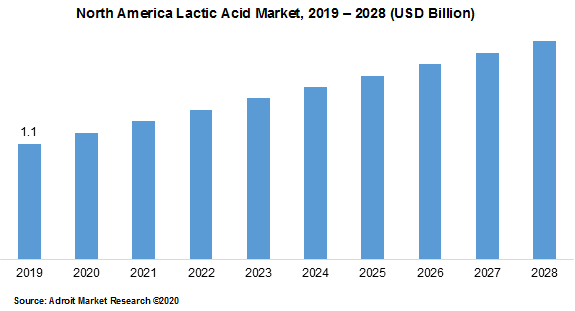The global Lactic Acid market is projected to reach USD 5.8 billion by 2030, growing at a CAGR of 8.0 %
.jpg
)
Global lactic acid accounted for a market size of USD 3.48 billion in the year 2019 and is projected to grow at a CAGR of more than 16 % over the forecast period. Lactic acid can be industrially synthesized by two means: chemically or microbially. Batch fermentation is commonly used to produce lactic acid. Lactonitrile is the common method for natural lactic acid synthesis. Fermentation is an energy cloud production process in which both electron donors and electron accepters play a significant part in organic movements. Lactic acid is one of the hydroxycarboxylic acids that are most commercially important.
Its applications include bulk manufacturing of products such as Poly Lactic Acid (PLA) in industry and in single household uses such as food container monitoring. Many inexpensive products, like starchy, cellulosic, recycled End-Uses, such as farm wastes, can be used as lactic acid raw End-Uses. The production of lactic acid from the raw End-Uses provided by bacteria and fungi is actively influenced by Microorganisms. The use of lactic acid in the production of different fermentation products not only as a raw substance but also in the food, pharmaceutical and textiles industries is of great importance.
Lactic Acid Market Scope
| Metrics | Details |
| Base Year | 2023 |
| Historic Data | 2018-2022 |
| Forecast Period | 2024-2030 |
| Study Period | 2018-2030 |
| Forecast Unit | Value (USD) |
| Revenue forecast in 2030 | USD 5.8 billion |
| Growth Rate | CAGR of 8.0% during 2020-2030 |
| Segment Covered | Raw Material, Application, Regions |
| Regions Covered | North America, Europe, Asia Pacific, South America, Middle East and Africa |
| Key Players Profiled | BASF SE, CSM N.V, The Dow Chemical Company, Teijin Ltd., NatureWorks LLC, CorbionPurac, Jungbunzlauer AG, Musashino Chemical Laboratory, Ltd., Galactic S.A., Henan Jindan Lactic Acid Co., Ltd. |
Key Segment Of The Lactic Acid Market
Raw Material, (USD Million)
• Corn
• Sugarcane
• Cassava
• Other Crops
Application, (USD Million)
• Industrial
• Food & Beverages
• Pharmaceuticals
• Personal Care
• Polylactic Acid (PLA)
• Others
Regional Overview, (USD Million)
North America
• US
• Canada
Europe
• Germany
• France
• UK
• Rest of Europe
Asia Pacific
• China
• India
• Japan
• Rest of Asia Pacific
South America
• Mexico
• Brazil
• Rest of South America
Middle East and South Africa
Frequently Asked Questions (FAQ) :
Lactic acid is also a widely used acidulant, flavouring agent, and inhibitor of bacteria, in the food pharmaceutical, preservation, and chemical industries. The ability for water preservation makes it useful in cosmetic products as a hydrator. It can be converted into valuable chemicals like bio resolves, esters, etc. due to the inclusion of hydroxyl and carboxyl groups in its composition. Lactic acid is also used in biodegradable poly lactic acid production as a monomer. Poly lactic acid (PLA) is the most recent trend in the use of lactic acid. PLA could be a potential substitute for plastics based on fossil fuels, but production costs should be reduced to half their current price, so that they can do so
The global lactic acid market is segmented into source and end-use. In terms of source the global lactic acid market is segmented into natural and synthetic. In terms of end-use the global lactic acid market is segmented into personal care, chemical, pharmaceutical, and others.
In terms of geography, the global Lactic Acid is segmented into North America, Europe, Asia Pacific, South America, and Middle East & Africa. North America dominated the global Lactic Acid market with a market revenue share of 30.5% in 2019.

Key players include, BASF SE, CSM N.V, The Dow Chemical Company, Teijin Ltd., NatureWorks LLC, CorbionPurac, Jungbunzlauer AG, Musashino Chemical Laboratory, Ltd., Galactic S.A., Henan Jindan Lactic Acid Co., Ltd.

